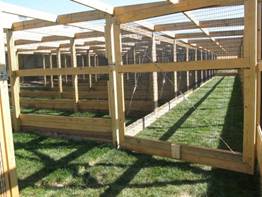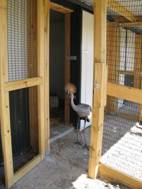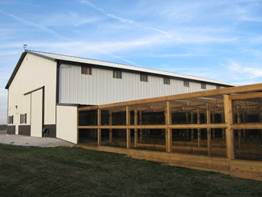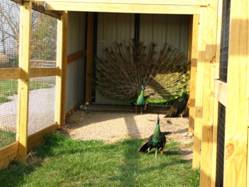Back to Peafowl Articles
Back to Aviary Facility
Peafowl Flight Pen Construction
Planning and building the pens for peafowl is one of the most important tasks that peafowl breeders will face as their flock size grows. The pens should provide plenty of space for the peafowl to breed and to coexist without being overcrowded. Pens should provide security from both air borne and ground based predators. Properly designed pens can keep peafowl healthy by preventing feral birds from entering the pens and transmitting diseases to the peafowl. Feral birds can also eat a lot of peafowl feed when flocks descend on poorly designed pens. Injuries to peafowl and their owners can be avoided by designing the pens so that the peafowl can be sorted and relocated without having to catch the birds in a net or cage. The purpose of this article is to share many of the ideas that we have incorporated in to our twelve, new flight pens. Please see the enclosed drawing of our flight pens to find dimensions and details our design work.
I
have raised animals and birds all my life and these experiences have helped me
to design our flight pens to allow for easy handling and sorting of birds
without having to catch them. If you
have ever attended a livestock auction in person you will have seen that the
animals are moved by a series of gates and aisle ways.
We have incorporated this idea in to our flight pens by making an 8
wide aisle way that runs the entire width of our flight pens.
The end gate of each flight pen opens in to this aisle way and will swing
open a full 90 degrees. This allows
for birds to be driven in to the aisle way for sorting or moving to a new pen
without being caught. The  aisle
way also serves as a security feature as well by providing a second enclosure
that the birds would have to escape from in order to get away in to the
wild. This idea is taken from zoos
that have large aviaries for birds that humans can enter and interact with the
birds. There are always 2 doors or
gates that the people have to go through in order to enter or exit the
aisle
way also serves as a security feature as well by providing a second enclosure
that the birds would have to escape from in order to get away in to the
wild. This idea is taken from zoos
that have large aviaries for birds that humans can enter and interact with the
birds. There are always 2 doors or
gates that the people have to go through in order to enter or exit the aviary. Gates are
positioned at each end of the aisle way and in the middle to provide maximum
access for grass mowing, landscaping equipment, and etc.
The aisle way gates swing out so that if a bird were to ever escape, they
could be driven back in to the aisle way with ease as long as they were on the
ground. Small swinging gates are
used in each pen to allow
us to access each pen with out having to walk through the entire length
of each pen or having to walk through the box stalls.
These gates can also be used to move birds from pen to pen.
aviary. Gates are
positioned at each end of the aisle way and in the middle to provide maximum
access for grass mowing, landscaping equipment, and etc.
The aisle way gates swing out so that if a bird were to ever escape, they
could be driven back in to the aisle way with ease as long as they were on the
ground. Small swinging gates are
used in each pen to allow
us to access each pen with out having to walk through the entire length
of each pen or having to walk through the box stalls.
These gates can also be used to move birds from pen to pen.
 on
average, 8 high. We will keep
pairs or trios of our breeder peafowl in each pen.
Our pens are built on the south side of our pole barn to provide maximum
shelter from the cold, northwest, winter, winds and to take advantage of any
winter sunshine. The first 10 of
the pens, leading away from the pole barn, are covered with metal, siding that
matches our pole barn. This provides
a covered resting area for the birds and provides protection to the box stall
entry doors from wind, rain, and snow. All
of the lumber used in our flight pens is pressure treated by a new process
called Micronized Copper Quaternary (MCQ). The
advantages of this new process are that the lumber is natural colored,
environmentally friendly, causes less corrosion of fasteners, and meets all code
requirements.
on
average, 8 high. We will keep
pairs or trios of our breeder peafowl in each pen.
Our pens are built on the south side of our pole barn to provide maximum
shelter from the cold, northwest, winter, winds and to take advantage of any
winter sunshine. The first 10 of
the pens, leading away from the pole barn, are covered with metal, siding that
matches our pole barn. This provides
a covered resting area for the birds and provides protection to the box stall
entry doors from wind, rain, and snow. All
of the lumber used in our flight pens is pressure treated by a new process
called Micronized Copper Quaternary (MCQ). The
advantages of this new process are that the lumber is natural colored,
environmentally friendly, causes less corrosion of fasteners, and meets all code
requirements.
 used
the wire. The perimeter sides of the
pens are covered with 1 x 1 wire to prevent feral birds and small
predators from being able to enter the pens.
The interior pen sides are covered with 1 x 2 wire.
Since the top and exterior sides are feral bird proof, money was saved by
using the 1 x 2 wire on the interior sides.
A pneumatic stapler was used to attach all of the wire to the pens.
The galvanized staples were 1 Ό in length and with a ½ crown.
The staples were spaced about 8 to 10 apart.
The perimeter of the pens is protected from digging predators by burying
1 x 2 wire under ground. An
electric fence wire is added mid height of the pen sides to prevent any
predators from climbing up the sides to try to chew through the top netting.
used
the wire. The perimeter sides of the
pens are covered with 1 x 1 wire to prevent feral birds and small
predators from being able to enter the pens.
The interior pen sides are covered with 1 x 2 wire.
Since the top and exterior sides are feral bird proof, money was saved by
using the 1 x 2 wire on the interior sides.
A pneumatic stapler was used to attach all of the wire to the pens.
The galvanized staples were 1 Ό in length and with a ½ crown.
The staples were spaced about 8 to 10 apart.
The perimeter of the pens is protected from digging predators by burying
1 x 2 wire under ground. An
electric fence wire is added mid height of the pen sides to prevent any
predators from climbing up the sides to try to chew through the top netting.
Back to Peafowl Articles
Back to Flight Pens
© 2008, Hopkins' Alternative Livestock
Web site designed and maintained by Lisa Hopkins